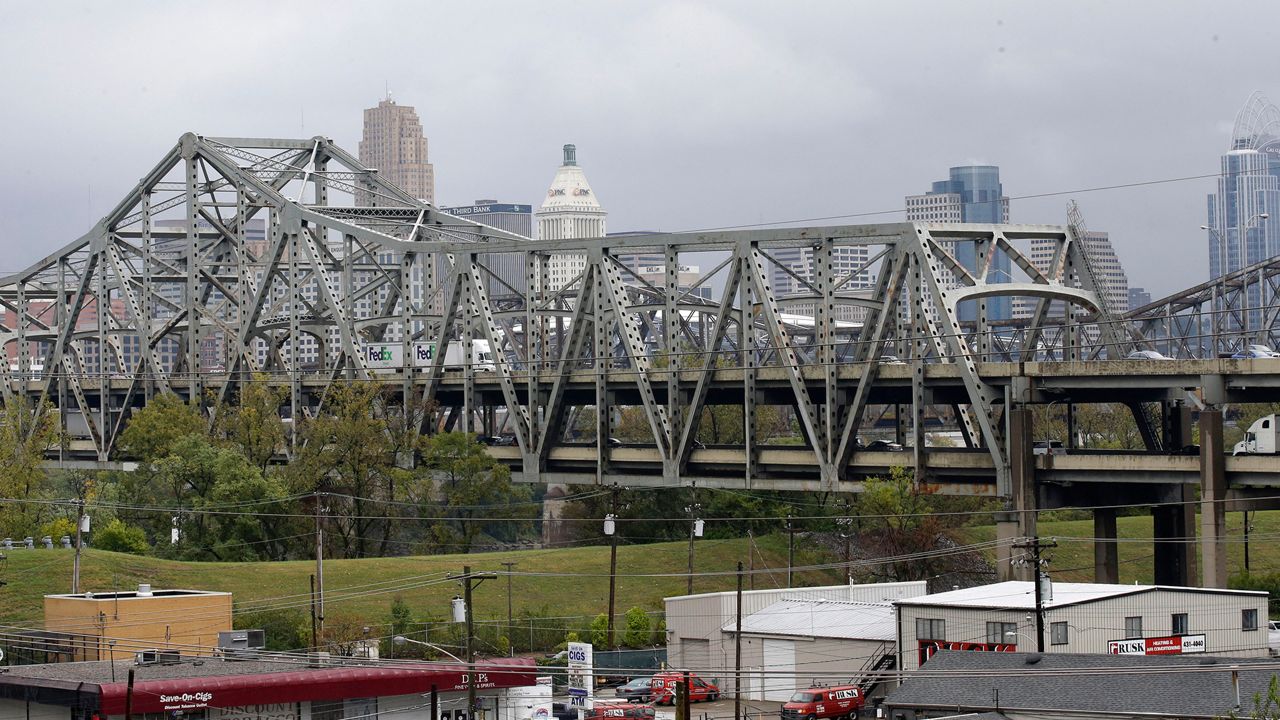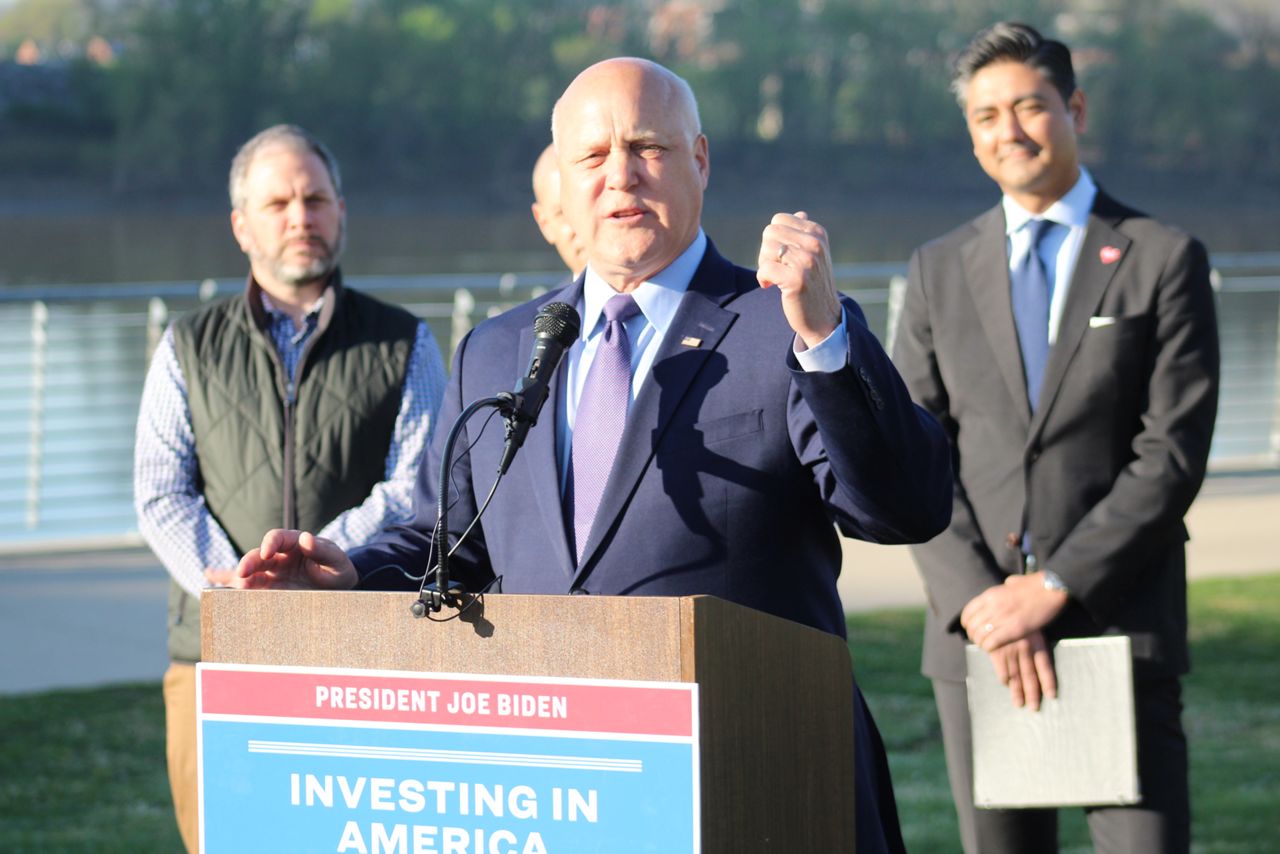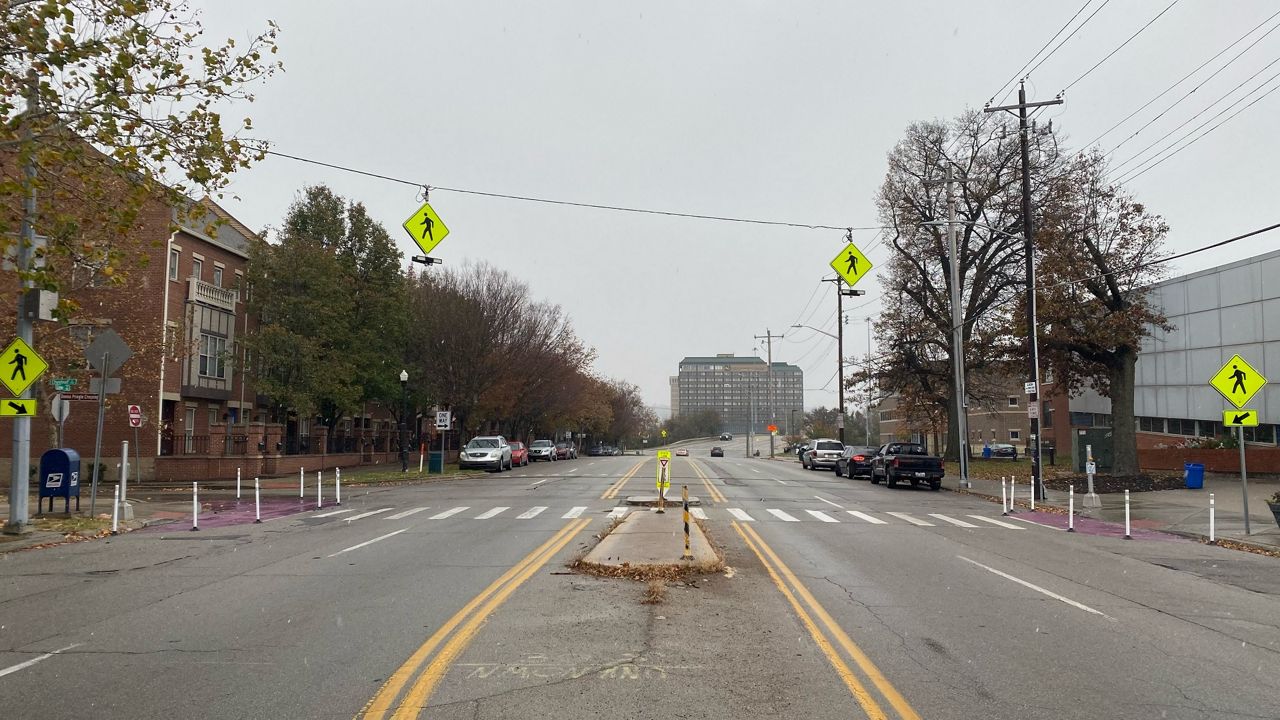CINCINNATI — U.S. Rep. Greg Landsman and senior White House adviser Mitch Landrieu held a press conference along the Ohio River on Thursday morning. But the star of the show was the Brent Spence Bridge.
What You Need To Know
- The press conference focused on progress on projects related to recent infrastructure spending programs from Washington, D.C.
- Rep. Greg Landsman's press conference at Smale Riverfront Park highlighted the Brent Spence Bridge
- Beyond being an "economic bonanza," city officials view the bridge construction as a job creation tool
- The media event was part of the Biden administration's “Investing in America” tour
Landsman and Landrieu — a former mayor of New Orleans — were in Cincinnati as part of the Biden administration’s three-week, 25-state “Investing in America” tour to highlight the proposed use of billions of federal dollars in an assortment of infrastructure projects.
During the tour, President Joe Biden, Vice President Kamala Harris and more than two dozen senior administration officials made trips to cities across the country to update residents on the status of those investments.
They specifically mentioned the dollars coming from several massive Washington, D.C., spending programs: the Bipartisan Infrastructure Law (BIL), the Inflation Reduction Act, the CHIPS and Science Act, and the American Rescue Plan.
The major talking point at Smale Riverfront Park on Thursday was the importance of securing $1.6 billion in BIL funding to support the reconfiguration of Brent Spence Bridge.

The Ohio-Kentucky connector is a vital commuter and commercial corridor, carrying more than $380 million in freight each year. But over the past 60 years, the bridge has become functionally obsolete, per the Ohio Department of Transportation.
Plans call for the construction of a companion span next to the existing Brent Spence Bridge. Additional related work throughout corridors on both sides of the Ohio River aims to improve overall traffic flow.
“This is about rebuilding America,” said Landsman, a Democrat elected to represent Ohio First Congressional District last November.
In January, Landrieu joined Biden and delegations from Ohio and Kentucky in Covington, Ky., to formally announce the grant award for the Brent Spence. It’s the largest single infrastructure project in U.S. history, Landrieu said.
The investment in the Cincinnati-Covington project is part of a $40 billion national effort to rebuild 15,000 bridges across the country, Landrieu added. He noted the White House has already invested in 4,600 of them in “some form or fashion.”
The initial timeline has work on the Brent Spence Bridge starting in November.
“(We’re) making key improvements to the Brent Spence Bridge that will get goods to communities more quickly, save taxpayers time and money by reducing congestion, and improve safety for commuters,” Landrieu said.
Investing in bridges to build communities
Even with large investments in state funding from Kentucky and Ohio, work on Brent Spence Bridge wouldn’t have been possible without the federal grant, said Matt Bruning, press secretary for ODOT.
Almost every project ODOT performs receives some federal money, Bruning said. In a typical year, that averages about $1.4 billion each year in federal funding. The BIL injected another $300 million into that pot annually.
“Unfortunately, a lot of those new dollars are getting swallowed by inflation,” he said. “The cost of everything to maintain and build our roadways has continued to go up year over year.”

While inflation is “eroding” some of ODOT’s capacity to take advantage of the new funding opportunities, those dollars are still helping them stay ahead of the curve, Bruning said.
This year, ODOT is doing a record $2.5 billion in work in the state on more than 1,000 projects.
Bruning stressed ODOT placed a lot of its attention early on ensuring the success of the Brent Spence Bridge funding. But he mentioned that other resources and federal grant dollars remain available.
“If there are federal-level programs that we feel can benefit Ohio, ODOT is going to pursue them to the greatest extent it can,” he said.
Those in attendance Thursday pointed out that the federal dollars’ potential impact is much larger than a single bridge. Billions of dollars are going toward initiatives ranging from public transportation and airports to clean water systems over the next decade.
Landsman referred to the money as “transformational.”
In the first 16 months, the federal government has awarded $210 billion in BIL funds to 25,000 projects.
Roughly $127 million of those dollars are going to the construction of a new Western Hills Viaduct. Another $20 million is supporting the reconfiguration of key travel areas from downtown to the west side. Dubbed the “State to Central: Building Better Neighborhoods” project, the work will better connect Cincinnati’s West End, Queensgate and Lower Price Hill neighborhoods through a combination of roadway improvements and on-street enhancements.
Cincinnati Mayor Aftab Pureval described the “Building Better Neighborhoods” as “stitching back together historically Black and brown communities torn apart by the construction of Interstate 75 decades ago.
The first-term mayor also views the plan for increasing the tree canopy in that area and adding bike and pedestrian-friendly elements as improving the quality of life for residents.
The city of Cincinnati has submitted other applications. He mentioned one that aims to “reconnect Evanston” and a “road diet” to improve street safety between Westwood and North Fairmount.
“This about making cities like Cincinnati safer, more cohesive and more equitable for working families,” Pureval said.

Following their visit to the Brent Spence Bridge, Landsman and Landrieu led a roundtable at Xavier University with leaders from businesses, nonprofits and community groups from Hamilton and Warren counties. Those two counties make up Ohio’s First Congressional District.
The group, which Landsman convenes somewhat regularly, shared information on the federal funding opportunities available to cities and organizations.
One project Landsman said they planned to discuss was the potential capping of Fort Washington Way.
“This is a thrilling time for our region,” added Jake Hesseling, manager of communications and legislative affairs Ohio-Kentucky-Indiana Regional Council of Governments (OKI).
The quasi-governmental organization that works with communities in eight counties to advocate for federal funding to support local and interstate projects. OKI has ultimate authority over all federal dollars spent on surface transportation in the region.
OKI awarded a historic $69 million in infrastructure funding last year, per Hesseling. That figure marks a 28% increase over 2021 ($54 million) and a 73% increase over 2020 ($40 million).
With much of the increase in federal funding taking place over five years, OKI expects a long-time horizon before this funding can “demonstrate its full impact,” Hesseling said.
“Those dollars are just now being put to use, and our communities will see their benefits as projects are completed,” he added.
You’ve got to spend money to make money
Brendon Cull attended Thursday’s press conference with his two young daughters. They’ll be of driving age when construction on Brent Spence Bridge wraps up in 2029, said Cull, the president of the Cincinnati USA Regional Chamber.
Cull joked about being happy that his kids won’t reach driving age until after crews complete the Brent Spence Bridge, saying he won’t have to worry about them “white knuckling it” while driving across it.
But Cull was all business when discussing the economic possibilities that come along with repairing it and making other meaningful investments in the region.
Businesses and other private sector organizations have made $435 billion in investments on top of those federal grant dollars, according to the White House.
“It’s an economic bonanza,” Cull said.
“This is more than a 10-year investment in a bridge,” he added. “It’s a 10-year economic boost for Cincinnati.”
This infrastructure work will require thousands of engineers, architects, planners, construction workers and skilled laborers, said Dave Baker, with Ironworkers Local 44. He described these next few years as an opportunity to “train the workforce we need for tomorrow.”
On Thursday, the Hamilton County Board of Commissioners approved the use of $225,000 in American Rescue Plan funding to support Building Futures-Southwest Ohio, a workforce development program that prepares people for building trade careers. It runs through the Urban League of Greater Southwestern Ohio.
“You want to raise minorities out of poverty? Build this bridge. You want to get women into construction? Build this bridge,” he added. “We’ve got an opportunity here of a lifetime.”



